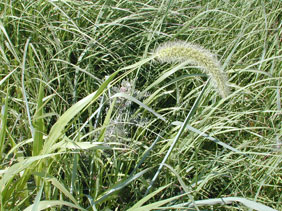GIANT FOXTAIL
|
 |
| File Size: 172 KB |
|
|
|
Setaria faberi Herrm.
|
| Riley County, Kansas |
| Annual |
| Height: 20-56 inches |
| Family: Poaceae - Grass Family |
| Flowering Period: July, August, September |
|
| Also Called: | | Giant bristlegrass, nodding foxtail, chinese foxtail. | | Culms: | | Ascending to erect, branching at base, hollow, glabrous, often bent over. | | Blades: | | Flat, linear, 5 to 20 inches long, .2 to .9 inch wide, upper surface typically soft-hairy, lower surface smooth to rough. | | Sheaths: | | Somewhat keeled, glabrous to scabrous, margins ciliate. | | Ligules: | | Fringe of hairs on a membranous base. | | Inflorescences: | | Panicle, dense, cylindrical, 3 to 8 inches long, .5 to 1.4 inch in diameter, often drooping. | | Spikelets: | | About 1/10 inch long, 2-flowered, first glume shorter than second, lemmas 1 fertile and 1 sterile, 3-6 bristles at base of each spikelet. | | Habitat: | | Waste areas, disturbed sites, roadsides, and cultivated ground. | | Distribution: | | Principally in the east 2/3 of Kansas. | | Origin: | | Giant foxtail was introduced from China and was first noted in the U.S. in the 1930's. | | Uses: | | Birds will eat the seeds. | | | | Giant foxtail is sometimes confused with green foxtail. Giant foxtail is taller, has a longer and wider inflorescence, and has pubescence on the upper surface of the leaves. |
|
| Giant foxtail |  | | 147 KB | | Riley County, Kansas |
| | | | | |
|
|
|
|
|
|